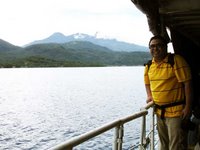 Camiguin is the second smallest province of the Philippines both in size and population. Only Batanes is smaller. But with a population density of 232 people per square kilometer, it is the 16th most densely-populated province.
Camiguin is the second smallest province of the Philippines both in size and population. Only Batanes is smaller. But with a population density of 232 people per square kilometer, it is the 16th most densely-populated province.
There are two ports in Camiguin that receive ferries from Balingoan, the one in Guinsiliban which is used by those with vehicles, and the one in Barangay Benoni in Mahinog which is the main passenger terminal since it is closer to Mambajao. There is another port in Barangay Balbagon, Mambajao but this is for Cebu-bound ferries. The fare from Balingoan is PHP100 plus a PHP7 terminal fee. The trip takes approximately an hour and 15 minutes. We left a little past 2 p.m. I arrived in Benoni at about 3:30 p.m. and took a jeepney from the terminal to Mambajao for PHP26. The trip was about 30 minutes. While on board the jeepney, I was floored by the number of ancestral homes still standing in Camiguin. The province continues to retain its character and old world charm. I would later learn after reading the DOT website that "Camiguin Island is famous for its ancestral homes gracefully dotting the streets all over the island" as well as its eight volcanoes which is why it is referred to as the island born of fire.I got off in the poblacion area and asked people at the municipio where I could find cheap lodging. Good thing there was a pension house a few meters away. I got an air-conditioned room at the GV Pension House good for two people for PHP500. A non-aircon room is PHP350.
I arrived in Benoni at about 3:30 p.m. and took a jeepney from the terminal to Mambajao for PHP26. The trip was about 30 minutes. While on board the jeepney, I was floored by the number of ancestral homes still standing in Camiguin. The province continues to retain its character and old world charm. I would later learn after reading the DOT website that "Camiguin Island is famous for its ancestral homes gracefully dotting the streets all over the island" as well as its eight volcanoes which is why it is referred to as the island born of fire.I got off in the poblacion area and asked people at the municipio where I could find cheap lodging. Good thing there was a pension house a few meters away. I got an air-conditioned room at the GV Pension House good for two people for PHP500. A non-aircon room is PHP350.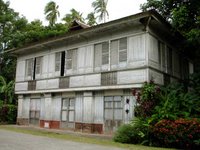 After freshening up, I went straight down to find a ride around town. I wanted to see as much as I could before dark. The hotel staff were very helpful and they got me a habal-habal which would take me to the sites in Catarman as well as the Ardent Hot Springs for just PHP300. It was worth it since he took me around for about 4 hours. The going rate for renting a motorcycle for 8 hours is PHP500 and that doesn't include gas and a driver.
After freshening up, I went straight down to find a ride around town. I wanted to see as much as I could before dark. The hotel staff were very helpful and they got me a habal-habal which would take me to the sites in Catarman as well as the Ardent Hot Springs for just PHP300. It was worth it since he took me around for about 4 hours. The going rate for renting a motorcycle for 8 hours is PHP500 and that doesn't include gas and a driver. Our first stop was the Sunken Cemetery in Barangay Bonbon, Catarman. On the way, I saw even more ancestral houses (above). As we neared Cataraman, I was treated to out of this world vistas of the Camiguin coastline, Mount Hibok-Hibok and Mount Vulcan Daan (left) up close.
Our first stop was the Sunken Cemetery in Barangay Bonbon, Catarman. On the way, I saw even more ancestral houses (above). As we neared Cataraman, I was treated to out of this world vistas of the Camiguin coastline, Mount Hibok-Hibok and Mount Vulcan Daan (left) up close. The sunken cemetery used to be part of the old capital of Camiguin. According to local historians, Mount Vulcan had four recorded eruptions. It was the third eruption in 1871 that sunk Cotta Bato and its cemetery under the sea. Remnants of the structures and gravestones were still seen during low tide but the fourth eruption in 1948 buried the area deeper by around twenty feet. In 1982, a large cross was built on the solidified lava to mark this old gravesite that has become known as the sunken cemetery and one of the world’s most unique diving sites since the coral-encrusted tombstones can be visited by divers.
The sunken cemetery used to be part of the old capital of Camiguin. According to local historians, Mount Vulcan had four recorded eruptions. It was the third eruption in 1871 that sunk Cotta Bato and its cemetery under the sea. Remnants of the structures and gravestones were still seen during low tide but the fourth eruption in 1948 buried the area deeper by around twenty feet. In 1982, a large cross was built on the solidified lava to mark this old gravesite that has become known as the sunken cemetery and one of the world’s most unique diving sites since the coral-encrusted tombstones can be visited by divers. After a few photos, we went to the ruins of the old church which was on top of a hill. The marker calls it the church of Cotta Bato, but some accounts call it the old church of Gui-ob. The walls, and parts of the belltower and convento are all that remain of this church.We then went back to the pension house so that I could change for the visit to Ardent. The hot spring was six kilometers from the poblacion in Barangay Tagdo, Mambajao. It is the most popular of Camiguin's hot springs. In the resort is a natural pool of about 40 degrees celsius coming from the bowels of Mt. Hibok-Hibok. The best time to go for a swim is late in the afternoon up to the evening, it closes at 10 p.m., so that you could really appreciate the warm water. You pay a PHP30 entrance fee.
After a few photos, we went to the ruins of the old church which was on top of a hill. The marker calls it the church of Cotta Bato, but some accounts call it the old church of Gui-ob. The walls, and parts of the belltower and convento are all that remain of this church.We then went back to the pension house so that I could change for the visit to Ardent. The hot spring was six kilometers from the poblacion in Barangay Tagdo, Mambajao. It is the most popular of Camiguin's hot springs. In the resort is a natural pool of about 40 degrees celsius coming from the bowels of Mt. Hibok-Hibok. The best time to go for a swim is late in the afternoon up to the evening, it closes at 10 p.m., so that you could really appreciate the warm water. You pay a PHP30 entrance fee. While I was getting “warmed” up, it started to rain. So I stayed in the water a bit longer hoping the rain would stop. But it didn’t. So I decided to have dinner at the place. The food was nothing great and quite expensive. It was not worth it. If it only stopped raining I would have eaten dinner in the town proper.Since it didn’t seem like the rain would stop, I decided to leave when the rain started to weaken. All I could remember was that I was shivering all the way back since I was soaking wet, the temperature was quite cold, and it was drizzling. I went straight to bed as soon as I got back to the pension house since I lacked sleep and I needed to be up at 5 a.m. the next day.
While I was getting “warmed” up, it started to rain. So I stayed in the water a bit longer hoping the rain would stop. But it didn’t. So I decided to have dinner at the place. The food was nothing great and quite expensive. It was not worth it. If it only stopped raining I would have eaten dinner in the town proper.Since it didn’t seem like the rain would stop, I decided to leave when the rain started to weaken. All I could remember was that I was shivering all the way back since I was soaking wet, the temperature was quite cold, and it was drizzling. I went straight to bed as soon as I got back to the pension house since I lacked sleep and I needed to be up at 5 a.m. the next day.
More photos of Camiguin in Multiply.
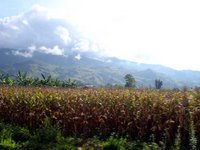 The bus left Davao City at 2:30 a.m. I tried to get as much sleep as I could but it was quite difficult since the seats were too stiff. Good thing I had the whole row to myself since there weren't a lot of passengers. So I was able to sleep on my backpack. The next thing I knew was the bus was already in Malaybalay, Bukidnon. The sun was already out but the temperature was quite cool. The climate in Malaybalay is very pleasing since it is located in a high altitude.It was back to sleep when we left the bus station and I woke up again when the bus stopped over for breakfast at a canteen in Impasug-Ong. The views of the nearby mountains were just spectacular. It reminded me that outside Metro Manila and its suburbs, so much of the Philippines is still pristine and untouched. I hope we keep these areas the way they are. From there, the road zigzagged up and down green mountains offering breathtaking views of the hilly agricultural province.I arrived at the Agora Bus Station in Cagayan de Oro at about 9 a.m. and could distinctly remember the hot and humid weather which greeted me when I got off the bus. I was told CDO has exceptionally hot weather. I waited there since my SSEAYP batchmates MJ and Simone Moneva were picking me up for breakfast.
The bus left Davao City at 2:30 a.m. I tried to get as much sleep as I could but it was quite difficult since the seats were too stiff. Good thing I had the whole row to myself since there weren't a lot of passengers. So I was able to sleep on my backpack. The next thing I knew was the bus was already in Malaybalay, Bukidnon. The sun was already out but the temperature was quite cool. The climate in Malaybalay is very pleasing since it is located in a high altitude.It was back to sleep when we left the bus station and I woke up again when the bus stopped over for breakfast at a canteen in Impasug-Ong. The views of the nearby mountains were just spectacular. It reminded me that outside Metro Manila and its suburbs, so much of the Philippines is still pristine and untouched. I hope we keep these areas the way they are. From there, the road zigzagged up and down green mountains offering breathtaking views of the hilly agricultural province.I arrived at the Agora Bus Station in Cagayan de Oro at about 9 a.m. and could distinctly remember the hot and humid weather which greeted me when I got off the bus. I was told CDO has exceptionally hot weather. I waited there since my SSEAYP batchmates MJ and Simone Moneva were picking me up for breakfast. We went straight to Rosario Arcade in Limketkai for a buffet breakfast at East Wok, a Chinese restaurant. The food was filling especially after the long trip from Davao. After breakfast, we passed by the Misamis Oriental Capitol for a while since MJ had to meet a client. So I was able to go around the capitol grounds with Sim. There was a provincial tourism and trade fair on the grounds so we went around to check it out.
We went straight to Rosario Arcade in Limketkai for a buffet breakfast at East Wok, a Chinese restaurant. The food was filling especially after the long trip from Davao. After breakfast, we passed by the Misamis Oriental Capitol for a while since MJ had to meet a client. So I was able to go around the capitol grounds with Sim. There was a provincial tourism and trade fair on the grounds so we went around to check it out.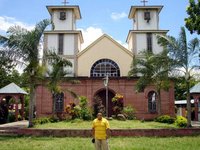 After that, we drove north towards Jasaan since I wanted to visit the church which was declared a national cultural treasure in 2001. On the way, we dropped Simone off at the Polymedic Hospital in Tagoloan since she had to meet her patients.
After that, we drove north towards Jasaan since I wanted to visit the church which was declared a national cultural treasure in 2001. On the way, we dropped Simone off at the Polymedic Hospital in Tagoloan since she had to meet her patients.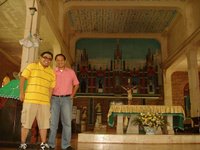 I was not quite impressed with the Jasaan Church. If it were compared to other churches in the country, it would look quite ordinary. It reminded me of my impressions of the churches in Tabaco, Albay and Bacong, Negros Oriental. I guess they declared it since it was the best-preserved church in Misamis Oriental and rare since it was in Mindanao. Built by the Jesuits in the late 19th to early 20th century, I think a more significant element of the church is its convent, an old wooden structure with huge wooden posts.
I was not quite impressed with the Jasaan Church. If it were compared to other churches in the country, it would look quite ordinary. It reminded me of my impressions of the churches in Tabaco, Albay and Bacong, Negros Oriental. I guess they declared it since it was the best-preserved church in Misamis Oriental and rare since it was in Mindanao. Built by the Jesuits in the late 19th to early 20th century, I think a more significant element of the church is its convent, an old wooden structure with huge wooden posts.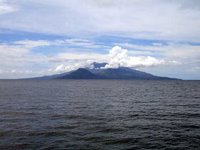 In Jasaan, I waited for a bus to the ferry terminal in Balingoan which was still an hour away. I spent PHP50 for the bus ride. There used to be fastcrafts from Cagayan de Oro to Camiguin but since some politicians in Camiguin wanted to earn from it as well, the operator had no choice but to increase his fare to accommodate this unnecessary expense. As a result, people still used the ferry service in Balingoan and the one from CDO was forced to close. So one has no choice but to use this slow ferry service to the island.
In Jasaan, I waited for a bus to the ferry terminal in Balingoan which was still an hour away. I spent PHP50 for the bus ride. There used to be fastcrafts from Cagayan de Oro to Camiguin but since some politicians in Camiguin wanted to earn from it as well, the operator had no choice but to increase his fare to accommodate this unnecessary expense. As a result, people still used the ferry service in Balingoan and the one from CDO was forced to close. So one has no choice but to use this slow ferry service to the island.
More photos of Misamis Oriental in Multiply.
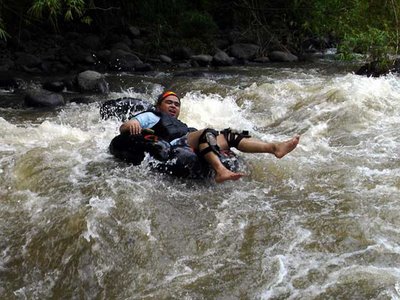 Today, it was time to get wet and wild in Santa Cruz, Davao del Sur which is known for its whitewater tubing in the Sibulan River in Darong, a barangay quite close to the boundary of Davao City.
Today, it was time to get wet and wild in Santa Cruz, Davao del Sur which is known for its whitewater tubing in the Sibulan River in Darong, a barangay quite close to the boundary of Davao City.
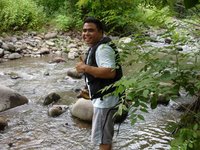 If you don’t have a car, you could simply take any public transportation going towards the direction of Santa Cruz. Although you will have to keep your eye open since there isn’t any signage along the highway pointing towards the attraction. Look out for the sign pointing to Barangay Sibulan and the Ayala Agricultural Development Corporation and make a right there.
If you don’t have a car, you could simply take any public transportation going towards the direction of Santa Cruz. Although you will have to keep your eye open since there isn’t any signage along the highway pointing towards the attraction. Look out for the sign pointing to Barangay Sibulan and the Ayala Agricultural Development Corporation and make a right there.
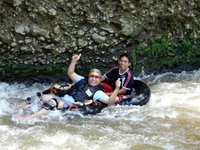 It’s about 100 meters from the national highway and the road is quite bumpy. You’ll know you’re in the right place if you see a copra processing area. The base camp of the whitewater tubing is in front of the Ayala Canteen. Just ask around if you’re not sure but you make a left there into an open space used for parking. Don’t be surprised when you see an extra PHP40 in your bill since they charge for parking.
It’s about 100 meters from the national highway and the road is quite bumpy. You’ll know you’re in the right place if you see a copra processing area. The base camp of the whitewater tubing is in front of the Ayala Canteen. Just ask around if you’re not sure but you make a left there into an open space used for parking. Don’t be surprised when you see an extra PHP40 in your bill since they charge for parking.
 The whitewater tubing at Darong is quite affordable since you won’t spend more than PHP400 per head. You basically pay for a guide which is one is to one, rental fees for the tube and the gear and the habal-habal (motorcycle) ride up to the starting point.It’s a muddy and rocky road up to the starting point. And from the road, you will have to walk about 100 more meters down to the river along a slippery and muddy trail. So better make sure you bring a trusty pair of sandals since I was wearing slippers and ended up having to take them off.
The whitewater tubing at Darong is quite affordable since you won’t spend more than PHP400 per head. You basically pay for a guide which is one is to one, rental fees for the tube and the gear and the habal-habal (motorcycle) ride up to the starting point.It’s a muddy and rocky road up to the starting point. And from the road, you will have to walk about 100 more meters down to the river along a slippery and muddy trail. So better make sure you bring a trusty pair of sandals since I was wearing slippers and ended up having to take them off.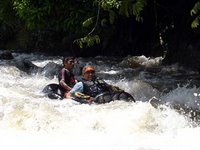 Anyway, I was relieved when we finally got to the river since it was simply fun, fun, fun all the way down to the base camp. Better be ready for some scratches and small bruises here and there but there’s nothing to worry about since the guides are very experienced.
Anyway, I was relieved when we finally got to the river since it was simply fun, fun, fun all the way down to the base camp. Better be ready for some scratches and small bruises here and there but there’s nothing to worry about since the guides are very experienced.
You’ll definitely fall off the tube at one or two of the rapids so don’t panic since the water is quite shallow. Just hold on to the tube and try to keep your legs up so you do not hit the rocks. Anyway, your guide will be there to hold on to you if you aren’t able to grip the tube.
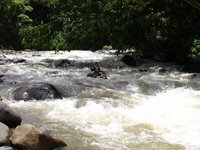 It would take about 2 hours to complete the basic route. I fell once during this run. But I escaped with just a few scratches and a sore toe which hit one of the rocks while I was on the tube. Hehe! But if I had more time, I would have done a second round or started from a higher point. Also try to avoid going here on a weekend if you want the river and the base camp all to yourself. It seemed we were the only clients for the day. Hehe!
It would take about 2 hours to complete the basic route. I fell once during this run. But I escaped with just a few scratches and a sore toe which hit one of the rocks while I was on the tube. Hehe! But if I had more time, I would have done a second round or started from a higher point. Also try to avoid going here on a weekend if you want the river and the base camp all to yourself. It seemed we were the only clients for the day. Hehe!
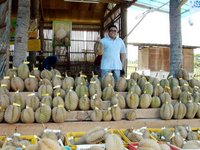 On the way back to Davao City, we were able to spot a durian stand selling the fruit for as low as PHP25 a kilo. The arancillo variety we got was PHP40 a kilo and it was much better than the one I had the night before. Indeed it tastes like heaven but I think the part which says it smells like hell is quite exaggerated since it wasn’t that bad.
On the way back to Davao City, we were able to spot a durian stand selling the fruit for as low as PHP25 a kilo. The arancillo variety we got was PHP40 a kilo and it was much better than the one I had the night before. Indeed it tastes like heaven but I think the part which says it smells like hell is quite exaggerated since it wasn’t that bad.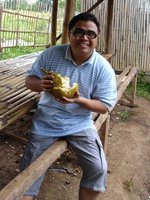 There were vendors also selling marang so how could I resist. I got one piece for PHP20. So we had fruits for our late breakfast. One thing I wasn’t able to try out though was mangosteen. Maybe I will during my next visit to Davao.I was planning to visit the Philippine Eagle Research and Nature Center but since I had been there already, we decided instead to rush back to the city proper for a late lunch since we wanted to catch the buy one, take one pizzas at Picobello, a classy Italian restaurant in the Gaisano South Ilustre mall which is frequented by Davao expats in the evenings. This promo is available only from 2 to 5 p.m. I spent about PHP260 for the two pizzas we ordered.
There were vendors also selling marang so how could I resist. I got one piece for PHP20. So we had fruits for our late breakfast. One thing I wasn’t able to try out though was mangosteen. Maybe I will during my next visit to Davao.I was planning to visit the Philippine Eagle Research and Nature Center but since I had been there already, we decided instead to rush back to the city proper for a late lunch since we wanted to catch the buy one, take one pizzas at Picobello, a classy Italian restaurant in the Gaisano South Ilustre mall which is frequented by Davao expats in the evenings. This promo is available only from 2 to 5 p.m. I spent about PHP260 for the two pizzas we ordered.
 For dinner, I met up with my SSEAYP batchmate Steve who took me to Jack’s Ridge, a popular dining area which offers a commanding view of the city’s skyline (right) and the Davao Gulf. The ridge was actually the headquarters of the retreating Japanese forces towards the end of the Second World War and is replete with caves dug up by the Japanese as well as bullets and other war materials in the rocky soil. There is also rumor that somewhere in the caves is hidden part of the Yamashita loot.
For dinner, I met up with my SSEAYP batchmate Steve who took me to Jack’s Ridge, a popular dining area which offers a commanding view of the city’s skyline (right) and the Davao Gulf. The ridge was actually the headquarters of the retreating Japanese forces towards the end of the Second World War and is replete with caves dug up by the Japanese as well as bullets and other war materials in the rocky soil. There is also rumor that somewhere in the caves is hidden part of the Yamashita loot.
 Anyway, after that great dinner, I rushed to the Matina Town Square since I was going to meet more of my Davao brods at Kanto Bar. We had an interesting discussion and ended quite late. To make the long story short, we got to the bus terminal quite late and the next bus leaving for Cagayan de Oro was still at 2:30 a.m. The last aircon bus leaves at 10 p.m. so I had to make do with the de luxe buses. I wonder why they call the non-aircon buses de luxe. Hehe! I paid PHP365 for the seven hour trip from Davao City to Cagayan de Oro.
Anyway, after that great dinner, I rushed to the Matina Town Square since I was going to meet more of my Davao brods at Kanto Bar. We had an interesting discussion and ended quite late. To make the long story short, we got to the bus terminal quite late and the next bus leaving for Cagayan de Oro was still at 2:30 a.m. The last aircon bus leaves at 10 p.m. so I had to make do with the de luxe buses. I wonder why they call the non-aircon buses de luxe. Hehe! I paid PHP365 for the seven hour trip from Davao City to Cagayan de Oro.
More photos of Davao del Sur and Davao City in Multiply.
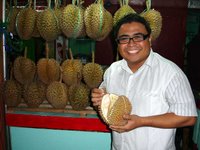 I'm finally back in Davao City. This was thanks to another of those one-peso fare tickets on Cebu Pacific I had booked earlier this year. And I'm simply reaping the fruits of my foresight. Hehe! I had taken a flight just a month ago and a lot's changed since then. Imagine what one "terror expert" could do to the entire security system! I knew about the ban on liquids which is why I purposely did not bring any gel, toothpaste and other liquids so that I would not have to check-in my backpack. But I ended up having to check it in because anything with wires is not allowed on hand-carried luggage as well, phone chargers included!
I'm finally back in Davao City. This was thanks to another of those one-peso fare tickets on Cebu Pacific I had booked earlier this year. And I'm simply reaping the fruits of my foresight. Hehe! I had taken a flight just a month ago and a lot's changed since then. Imagine what one "terror expert" could do to the entire security system! I knew about the ban on liquids which is why I purposely did not bring any gel, toothpaste and other liquids so that I would not have to check-in my backpack. But I ended up having to check it in because anything with wires is not allowed on hand-carried luggage as well, phone chargers included!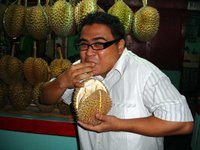 As I entered the waiting area, I had to wait a bit since passengers were taking off their shoes for the x-ray. The security personnel also asked us to remove our belts, eyeglasses and everything else in our pockets. Anyway, I guess this is for our safety.I arrived in Davao City at about 5:30 p.m. just in time for dinner. My brod Jepri passed by for me at the Davao International Airport which is a new airport by the way. I was impressed with the facilities especially since the Manila Domestic Airport is such a shame!
As I entered the waiting area, I had to wait a bit since passengers were taking off their shoes for the x-ray. The security personnel also asked us to remove our belts, eyeglasses and everything else in our pockets. Anyway, I guess this is for our safety.I arrived in Davao City at about 5:30 p.m. just in time for dinner. My brod Jepri passed by for me at the Davao International Airport which is a new airport by the way. I was impressed with the facilities especially since the Manila Domestic Airport is such a shame!
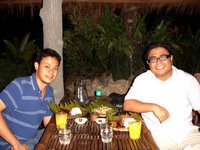 We ate at this new place called Gardena Fresca which was a garden restaurant that served ihaw-ihaw among others. We got ourselves some pork ribs if I'm not mistaken and an order of guso or seaweed salad. I spent PHP90 for the package meal which comes with fruits and juice and an extra PHP45 for the guso.
We ate at this new place called Gardena Fresca which was a garden restaurant that served ihaw-ihaw among others. We got ourselves some pork ribs if I'm not mistaken and an order of guso or seaweed salad. I spent PHP90 for the package meal which comes with fruits and juice and an extra PHP45 for the guso.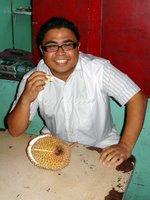 After dinner, we met up with my SSEAYP batchmate Steve, who was meeting with other SSEAYP alumni from Davao at a coffee shop. Didn't stay that long since I was craving for durian. And we ate some at Magsaysay Park. Yummy! Hehe! The arancillo variety was PHP50 a kilo.
After dinner, we met up with my SSEAYP batchmate Steve, who was meeting with other SSEAYP alumni from Davao at a coffee shop. Didn't stay that long since I was craving for durian. And we ate some at Magsaysay Park. Yummy! Hehe! The arancillo variety was PHP50 a kilo.
After that heavenly snack, they say durian tastes like heaven but smells like hell, we went for a Swedish massage. I'm going to bed quite early since we have a lot planned tomorrow. Anyway, more tomorrow.
I made another trip to Lingayen, Pangasinan today to attend to some business at the elegant Pangasinan Provincial Capitol. I left Pampanga together with my brods Ryan and Adrei at 6 a.m. We were rushing since we had to be there at 9 a.m. So the only stopover we made was at the Jollibee drive-thru in Luisita. The fastest route to Lingayen is via Santa Ignacia and Camiling, Tarlac passing through the town of San Clemente before reaching the first town of Pangasinan which is Mangatarem. Camiling used to have a grand church, the oldest and largest church in Tarlac. But unfortunately, this heritage church got burned in April 1997. I noticed that Camiling still has a lot of heritage structures around the poblacion area. If the local government unit is able to do things right they could still save the character of the town.As we entered Pangasinan we were greeted by some of the best views of the Philippine countryside. The rice crop was just about ready for harvesting so the fields were immaculately green with the rice grains at a golden brown. Behind the fields were the foothills of the Zambales mountains. If only we had time to stop over. Sigh!
The fastest route to Lingayen is via Santa Ignacia and Camiling, Tarlac passing through the town of San Clemente before reaching the first town of Pangasinan which is Mangatarem. Camiling used to have a grand church, the oldest and largest church in Tarlac. But unfortunately, this heritage church got burned in April 1997. I noticed that Camiling still has a lot of heritage structures around the poblacion area. If the local government unit is able to do things right they could still save the character of the town.As we entered Pangasinan we were greeted by some of the best views of the Philippine countryside. The rice crop was just about ready for harvesting so the fields were immaculately green with the rice grains at a golden brown. Behind the fields were the foothills of the Zambales mountains. If only we had time to stop over. Sigh!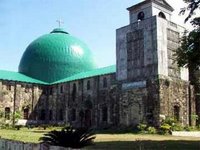 Anyway, Mangatarem had a really old church and intact convento. You would immediately notice it because of its oversized turquoise blue dome. I promised myself to check it out on the way back. There were several Gabaldon schoolhouses and a colonial period town hall as well. The next town Aguilar had an equally impressive church as well as an intact covento very similar to the one in Mangatarem.After passing through the town of Bugallon, we made a right at the intersection following the road to Dagupan. Lingayen was just a few kilometers away. You could immediately see the belltower of the church as you neared the capital town of Pangasinan. As you enter, you are greeted by several ancestral houses.
Anyway, Mangatarem had a really old church and intact convento. You would immediately notice it because of its oversized turquoise blue dome. I promised myself to check it out on the way back. There were several Gabaldon schoolhouses and a colonial period town hall as well. The next town Aguilar had an equally impressive church as well as an intact covento very similar to the one in Mangatarem.After passing through the town of Bugallon, we made a right at the intersection following the road to Dagupan. Lingayen was just a few kilometers away. You could immediately see the belltower of the church as you neared the capital town of Pangasinan. As you enter, you are greeted by several ancestral houses.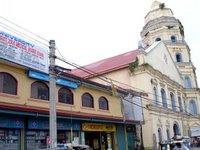 Although there are still a large number of heritage structures in the town, Lingayen is on the verge of transforming itself into another nondescript Filipino community without character. The stupid parish priest had demolished a centuries-old brick convento and replaced it with commercial stalls (left). The parish priest could have preserved the convento by employing adaptive re-use, altering the interiors to accomodate commercial stalls.
Although there are still a large number of heritage structures in the town, Lingayen is on the verge of transforming itself into another nondescript Filipino community without character. The stupid parish priest had demolished a centuries-old brick convento and replaced it with commercial stalls (left). The parish priest could have preserved the convento by employing adaptive re-use, altering the interiors to accomodate commercial stalls. In the center of town is a modern public market. But just beside it is one of the best-preserved Spanish colonial period casas reales in the country (right) which is now used by the Sangguniang Bayan of Lingayen. If only the local government in Lingayen was able to regulate the designs of these new buildings. There is a proper way of building new structures in old districts. Scale and proportions are very important.
In the center of town is a modern public market. But just beside it is one of the best-preserved Spanish colonial period casas reales in the country (right) which is now used by the Sangguniang Bayan of Lingayen. If only the local government in Lingayen was able to regulate the designs of these new buildings. There is a proper way of building new structures in old districts. Scale and proportions are very important. We finally made it to the Pangasinan Capitol after two hours and thirty minutes traveling. It was the second time for me to visit the building. And looking at the stately building which the provincial government painstakingly restored to its pristine condition gives me hope for heritage. The governor is in the process of landscaping the boulevard and open spaces that lead to the said building. For this I say, "Bravo Governor Agbayani!" It's sad that he is on his third term.
We finally made it to the Pangasinan Capitol after two hours and thirty minutes traveling. It was the second time for me to visit the building. And looking at the stately building which the provincial government painstakingly restored to its pristine condition gives me hope for heritage. The governor is in the process of landscaping the boulevard and open spaces that lead to the said building. For this I say, "Bravo Governor Agbayani!" It's sad that he is on his third term. After our meeting we visited the beach right at the back of the Capitol which was the landing site of Gen. Douglas MacArthur in Lingayen. On display are some World War II relics such as a fighter plane and a tank, as well as old photos in an exhibit area built by the LGU. We made our way to the fine gray sand beach which had a hotel and huts-for-rent.We didn't have much time since we wanted to be in Pampanga before 5 p.m. So we made our way back after a quick lunch.
After our meeting we visited the beach right at the back of the Capitol which was the landing site of Gen. Douglas MacArthur in Lingayen. On display are some World War II relics such as a fighter plane and a tank, as well as old photos in an exhibit area built by the LGU. We made our way to the fine gray sand beach which had a hotel and huts-for-rent.We didn't have much time since we wanted to be in Pampanga before 5 p.m. So we made our way back after a quick lunch.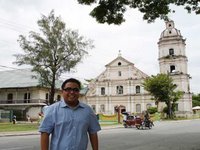 We were able to take photos at the Aguilar Church which was still very much intact except for the fact that they had replaced the old floor tiles with cheap marble. We really need to educate our priests and parish pastoral councils. I saw remnants of the black and white tiles outside and could imagine how much more charming the interior of the church would have looked with those tiles.
We were able to take photos at the Aguilar Church which was still very much intact except for the fact that they had replaced the old floor tiles with cheap marble. We really need to educate our priests and parish pastoral councils. I saw remnants of the black and white tiles outside and could imagine how much more charming the interior of the church would have looked with those tiles.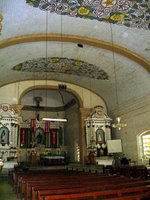 The ceiling, choirloft, pulpit and retablo were intact as well and I hope it remains that way. Right beside it was the original convento which except for the cement palitada inside, was very much the same structure. FYI, there is a proper mixture of palitada for these old churches and the current cement mixture is too strong and does not allow the structure to breathe.After Aguilar, I can't remember what happened since I was too tired and lacked sleep having slept for only an hour the night before. So I was asleep for most of the trip back and thus missed stopovers at Mangatarem and Camiling. Oh well, maybe next time!
The ceiling, choirloft, pulpit and retablo were intact as well and I hope it remains that way. Right beside it was the original convento which except for the cement palitada inside, was very much the same structure. FYI, there is a proper mixture of palitada for these old churches and the current cement mixture is too strong and does not allow the structure to breathe.After Aguilar, I can't remember what happened since I was too tired and lacked sleep having slept for only an hour the night before. So I was asleep for most of the trip back and thus missed stopovers at Mangatarem and Camiling. Oh well, maybe next time!
 Camiguin is the second smallest province of the Philippines both in size and population. Only Batanes is smaller. But with a population density of 232 people per square kilometer, it is the 16th most densely-populated province.
Camiguin is the second smallest province of the Philippines both in size and population. Only Batanes is smaller. But with a population density of 232 people per square kilometer, it is the 16th most densely-populated province. I arrived in Benoni at about 3:30 p.m. and took a jeepney from the terminal to Mambajao for PHP26. The trip was about 30 minutes. While on board the jeepney, I was floored by the number of ancestral homes still standing in Camiguin. The province continues to retain its character and old world charm. I would later learn after reading the DOT website that "Camiguin Island is famous for its ancestral homes gracefully dotting the streets all over the island" as well as its eight volcanoes which is why it is referred to as the island born of fire.
I arrived in Benoni at about 3:30 p.m. and took a jeepney from the terminal to Mambajao for PHP26. The trip was about 30 minutes. While on board the jeepney, I was floored by the number of ancestral homes still standing in Camiguin. The province continues to retain its character and old world charm. I would later learn after reading the DOT website that "Camiguin Island is famous for its ancestral homes gracefully dotting the streets all over the island" as well as its eight volcanoes which is why it is referred to as the island born of fire. After freshening up, I went straight down to find a ride around town. I wanted to see as much as I could before dark. The hotel staff were very helpful and they got me a habal-habal which would take me to the sites in Catarman as well as the Ardent Hot Springs for just PHP300. It was worth it since he took me around for about 4 hours. The going rate for renting a motorcycle for 8 hours is PHP500 and that doesn't include gas and a driver.
After freshening up, I went straight down to find a ride around town. I wanted to see as much as I could before dark. The hotel staff were very helpful and they got me a habal-habal which would take me to the sites in Catarman as well as the Ardent Hot Springs for just PHP300. It was worth it since he took me around for about 4 hours. The going rate for renting a motorcycle for 8 hours is PHP500 and that doesn't include gas and a driver. Our first stop was the Sunken Cemetery in Barangay Bonbon, Catarman. On the way, I saw even more ancestral houses (above). As we neared Cataraman, I was treated to out of this world vistas of the Camiguin coastline, Mount Hibok-Hibok and Mount Vulcan Daan (left) up close.
Our first stop was the Sunken Cemetery in Barangay Bonbon, Catarman. On the way, I saw even more ancestral houses (above). As we neared Cataraman, I was treated to out of this world vistas of the Camiguin coastline, Mount Hibok-Hibok and Mount Vulcan Daan (left) up close. The sunken cemetery used to be part of the old capital of Camiguin. According to local historians, Mount Vulcan had four recorded eruptions. It was the third eruption in 1871 that sunk Cotta Bato and its cemetery under the sea. Remnants of the structures and gravestones were still seen during low tide but the fourth eruption in 1948 buried the area deeper by around twenty feet. In 1982, a large cross was built on the solidified lava to mark this old gravesite that has become known as the sunken cemetery and one of the world’s most unique diving sites since the coral-encrusted tombstones can be visited by divers.
The sunken cemetery used to be part of the old capital of Camiguin. According to local historians, Mount Vulcan had four recorded eruptions. It was the third eruption in 1871 that sunk Cotta Bato and its cemetery under the sea. Remnants of the structures and gravestones were still seen during low tide but the fourth eruption in 1948 buried the area deeper by around twenty feet. In 1982, a large cross was built on the solidified lava to mark this old gravesite that has become known as the sunken cemetery and one of the world’s most unique diving sites since the coral-encrusted tombstones can be visited by divers. After a few photos, we went to the ruins of the old church which was on top of a hill. The marker calls it the church of Cotta Bato, but some accounts call it the old church of Gui-ob. The walls, and parts of the belltower and convento are all that remain of this church.
After a few photos, we went to the ruins of the old church which was on top of a hill. The marker calls it the church of Cotta Bato, but some accounts call it the old church of Gui-ob. The walls, and parts of the belltower and convento are all that remain of this church. While I was getting “warmed” up, it started to rain. So I stayed in the water a bit longer hoping the rain would stop. But it didn’t. So I decided to have dinner at the place. The food was nothing great and quite expensive. It was not worth it. If it only stopped raining I would have eaten dinner in the town proper.
While I was getting “warmed” up, it started to rain. So I stayed in the water a bit longer hoping the rain would stop. But it didn’t. So I decided to have dinner at the place. The food was nothing great and quite expensive. It was not worth it. If it only stopped raining I would have eaten dinner in the town proper.


























